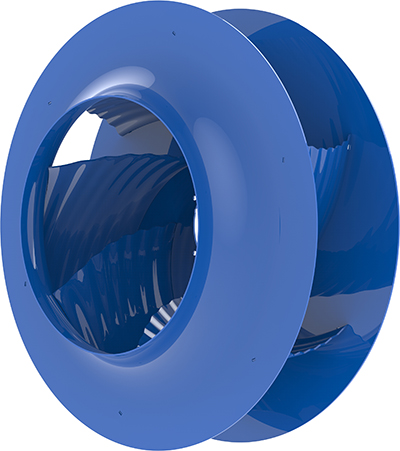 Ziehl-Abegg has been doing a lot of interesting things with what they term bionic profiling—for example, their latest generation of radial fans comes from the humpback whale; allowing for energy savings of up to 10%. The company says it can delivers peak efficiency in excess of 70% in its radial fans.
Ziehl-Abegg has been doing a lot of interesting things with what they term bionic profiling—for example, their latest generation of radial fans comes from the humpback whale; allowing for energy savings of up to 10%. The company says it can delivers peak efficiency in excess of 70% in its radial fans.
I spoke with Rainer Grill at the company’s booth at the recent Hannover Messe press preview, and he told me that this type of biomimicry design is very helpful in creating more efficient products.
“With electric motors, one problem is the noise and the efficiency,” he said. “A few years ago, we looked to see how we could reduce the noise—and it turns out we can reduce the noise by 50%. These rounded edges are the key. If you have one big turbulence area, it’s loud and it sucks a lot of energy. If you have some little turbulence ares, you reduce the noise 50%. This comes from the owl, which is known for being silent in the night. The owl has a lot of feathers, many little feathers, in the same way.”
Grill also said that the company has used everything from trees to ferns to even humpback whales to help revolutionize its designs.
When whales swim, the movement of their fins causes the angle to constantly change. If its pectoral fins were to be at too steep an angle to the counter-flow this would produce a lot of turbulence as the water passes over them. “The characteristic features of excessive turbulence are high flow losses and noise” says Dr. Walter Angelis, Technical Manager for Ventilation Systems at Ziehl-Abegg. Over millennia the humpback whale has optimised the design of its fins. For example, the leading edge of the whale’s fins contains golf ball sized bumps (technical term: tubercles). With its long pectoral fins, a whale weighing 25 to 30 tons can therefore swim very quickly and with great agility. “We have recreated this on the leading edge of the fan blade and implemented it as an undulating profile,” said Angelis.
The flow engineers have also taken a close look at the whale’s rear fin, the “fluke.” The v-shaped contour of the rear section of the wing delays potential flow breaks—enabling the fan to be used for numerous different pressure ranges. Overall, evolution has optimised the flow efficiency of the humpback whale in such a way that makes it a very good and agile swimmer despite its body size. Without this evolution its long journeys through the world’s oceans without taking in food would not be possible. The latest generation of radial fans at Ziehl-Abegg in sizes starting from 710 mm, is now benefitting from this knowledge gained in the field of bionics. The product name ZAbluefin is borrowed from the English.
“We have also fitted a torsion to the fan blade,” said Angelis. This creates an optimum angle of flow over the entire span. It’s not just the jagged trailing edges that make the impeller run quieter. The undulating design of the blade surfaces reduces the noise level.
The experts at Ziehl-Abegg have spent about two years on the new centrifugal impeller for air-handling units and industrial ventilation. A bionic profile has proven very effective in terms of efficiency and low-noise. With the bionic profile blades, unlike currently commercially available hollow profiled blades, there are no gaps into which dirt or condensation can penetrate, leading not only to corrosion but also creating an imbalance. The steel is therefore pressed into a corrugated shape using a 600-ton press, creating the bionic profile—“this gives us additional strength and enables us to optimise the weight,” emphasized Angelis. Less weight protects the bearings in the motor.
The new radial impeller therefore possesses characteristics from two completely different approaches to the field of bionics: both in terms of aerodynamics (ornithology) as well as hydrodynamics (marine biology). For example, the trailing edges of the ventilator blades recreate the flight of an owl. “As the quietest bird of prey, the owl has already been used by us as a model for a number of designs,” said Fenkl.


Leave a Reply
You must be logged in to post a comment.